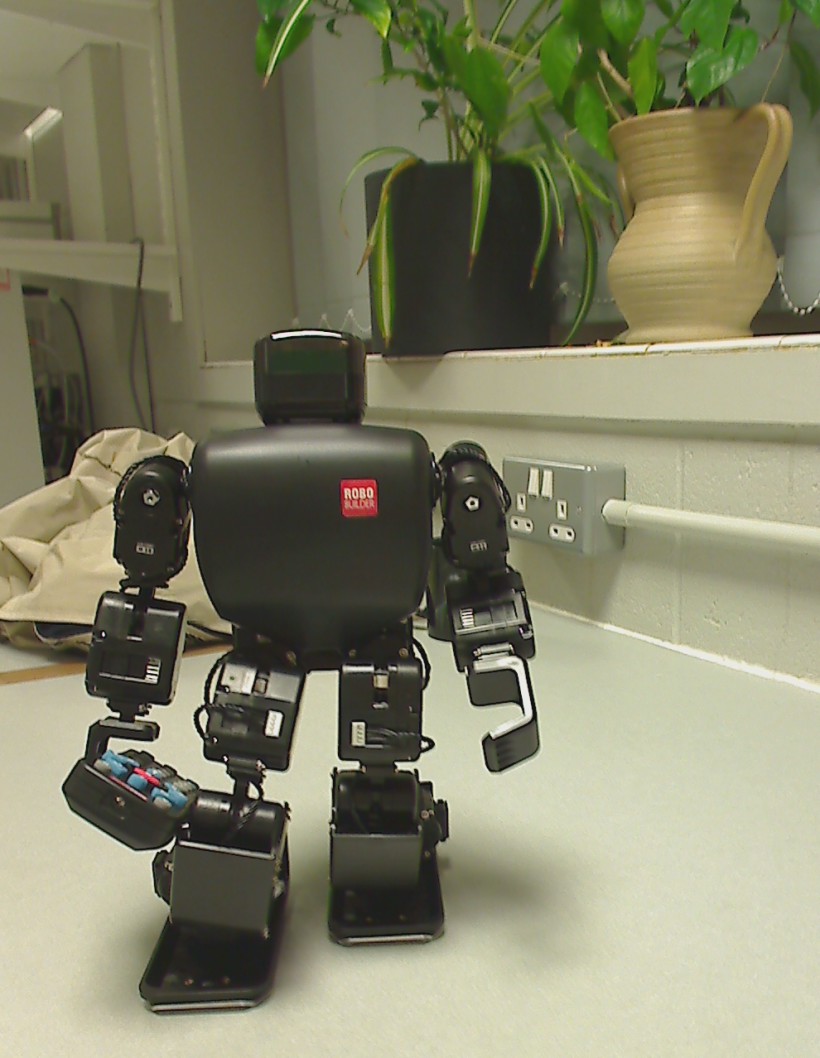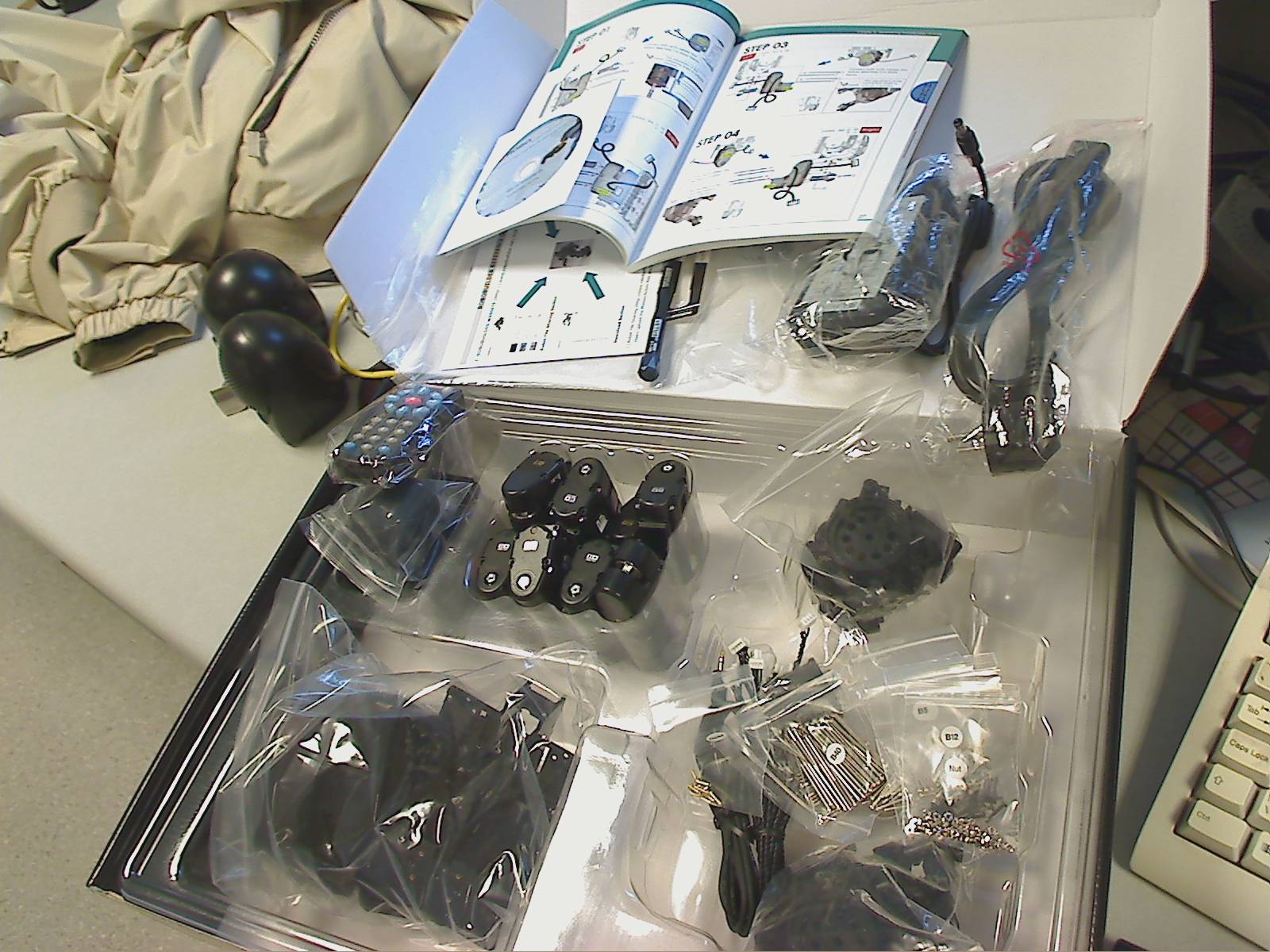Robobuilder
m (→External Links) |
m (→Robobuilder) |
||
| Line 21: | Line 21: | ||
|} | |} | ||
=Robobuilder= | =Robobuilder= | ||
| − | Currently all our Robobuilders are in disrepair (plastic gears of multiple servos are broken). We are trying to order [http://robosavvy.com/store/product_info.php/products_id/524 metal gear] replacements. | + | Currently all our Robobuilders are in disrepair (plastic gears of multiple servos are broken). We are trying to order [http://robosavvy.com/store/product_info.php/products_id/524 metal gear] replacements. [http://groups.csail.mit.edu/lbr/hrg/1995/mattw_ms_thesis.pdf Mark Williamson's thesis] (MIT) points out that the problem actually is the rigid design of robots such as the Robobuilder: 'The situation is further compounded by the choice of actuator. As the robots are stiff, their links tend to be heavy, so large forces are needed to accelerate them. Electric motors, which are the most common actuator type cannot generate large forces at low speeds, so gear reductions need to be used. These increase the power density at the expense of introducing friction, noise, backlash and torque ripple to the system. As the robot is stiff, these effects will be transmitted to the endpoint of the robot, giving poor performance. A further disadvantage is that the gears increase the reflected inertia of the motor, and the large shock loads which result from unexpected collisions can cause the gear teeth to break.'' |
| − | + | ||
[[Image:Working.gif]] | [[Image:Working.gif]] | ||
==Capabilities== | ==Capabilities== | ||
Revision as of 16:42, 26 October 2009
|
One can control the Robobuilder from within an interactive Ruby session (also available as 15.5 MByte DivX3 video and available on Youtube)
|
Contents |
Robobuilder
Currently all our Robobuilders are in disrepair (plastic gears of multiple servos are broken). We are trying to order metal gear replacements. Mark Williamson's thesis (MIT) points out that the problem actually is the rigid design of robots such as the Robobuilder: 'The situation is further compounded by the choice of actuator. As the robots are stiff, their links tend to be heavy, so large forces are needed to accelerate them. Electric motors, which are the most common actuator type cannot generate large forces at low speeds, so gear reductions need to be used. These increase the power density at the expense of introducing friction, noise, backlash and torque ripple to the system. As the robot is stiff, these effects will be transmitted to the endpoint of the robot, giving poor performance. A further disadvantage is that the gears increase the reflected inertia of the motor, and the large shock loads which result from unexpected collisions can cause the gear teeth to break.
![]()
Capabilities
- main body
- AVR microcontroller
- motion programs
- direct control
- 16 servo controllers, serial bus
- self-running mode
- interpolation + closed-loop control
- LiPo akku, DC power connector
- AVR microcontroller
- sensors
- 3-axis accelerometer (add-on)
- ultrasound distance sensor
- communication
- RS232 interface
- Bluetooth interface (add-on)
Ruby Examples
Using the RBC controller
You can download the Ruby-extension for controlling the Robobuilder using a GNU+Linux PC here:
Here is a small example program which makes the robot get up if it's lying on its back or its front.
#!/usr/bin/env ruby
require 'robobuilder'
require 'matrix'
class Vector
def norm
Math.sqrt inner_product( self )
end
end
robot = Robobuilder.new '/dev/ttyUSB0'
puts "Robobuilder"
puts "Serial number: #{robot.serial_number}"
acceleration = Vector[ *robot.accelerometer ]
if acceleration.inner_product( Vector[ 0, 0, 1 ] ) >
acceleration.norm * 0.97
robot.basic
robot.a
elsif acceleration.inner_product( Vector[ 0, 0, 1 ] ) <
-acceleration.norm * 0.97
robot.basic
robot.b
end
acceleration = Vector[ *robot.accelerometer ]
if acceleration.inner_product( Vector[ 0, 1, 0 ] ) >
acceleration.norm * 0.97
robot.run 1
end
robot.close
Todo
- Implement various commands of direct mode
- Implement commands for uploading motion sequences and action sequences
- Add support for Bluetooth communication
- Port wired and wireless serial communication to Windows
- Computer vision feedback using (external) webcam
External Links
- Robobuilder Ltd. (Korean manufacturer)
- Robosavvy (UK distributor)
- Robobuilder 5710K Humanoid Kit
- Robobuilder Bluetooth Communication Module (installation instructions)
- Robobuilder Triaxial Acceleration Sensor Module (installation instructions)
- Metal gear replacement for single servo
- Robobuilder Creator users manual
- Serial protocol to communicate with Robobuilder controller
- Source code of Robobuilder controller
- Forum post about this Ruby project
- RoboBuilder enhanced with RoBoard (capable of running GNU/Linux)
- Robodance (free software to control toy robots)
- Robobuilder base dance video
- Video of Robobuilder at Roboworld 2008 (Seoul)
- HOAP at the EPFL Laboratoire d'Algorithmes et Systemes d'Apprentissage
- Matt Williamson: Masters thesis on series elastic actuators

